24, Akbar Road has been the headquarters of India's oldest party for over three decades now.
From Indira Gandhi to Sonia Gandhi, the prestigious Lutyens bungalow has felt the presence of many high-profile leaders formulating policies and strategies for the party and the nation in general.
The changing facade and structure of the building -- as symbolic of the many shifts and changes in the outlook of the Congress party and its fluctuating fortunes -- have been compiled in a book by the same name by Rasheed Kidwai, who also wrote Sonia A Biography.
Here is an exclusive extract from 24, Akbar Road, to be released by Hachette Books India in August, that reveals how Rahul Gandhi has introduced a dynamic new brand of leadership within the Congress party. Kidwai also points out that Rahul's emergence as a mature politician has a distinct Sonia stamp and that he has, as a matter of fact, proved his worth.
Click on NEXT to read this exclusive extract:
An attempt to restore democracy within the Congress
Image: Rahul attends a meeting with Prime Minister Manmohan Singh and Congress President Sonia GandhiThe Sonia-Manmohan regime saw mass induction of professionals as politician or as functional head of some crucial sector -- Kapil Sibal, Jairam Ramesh, Sam Pitroda, Montek Singh Ahluwalia, C Rangarajan and dozens of others who were handpicked who called the shots. Some were in the Cabinet, others in the Planning Commission, National Advisory Council, Finance Commission, Prime Minister's Scientific Advisory Council, Knowledge Commission or enrolled as interlocutors for behind-the-scenes talks with the US, Pakistan and China. Like Rajiv's Mumbai speech of 1985, Rahul was aiming at a paradigm shift in the country' politics, which were steeped in caste equations and corruption.
Thus, on the face of it, traditional politicians appeared to be in charge of big portfolios but in reality, their influence was on the wane. Their places were discreetly taken over by highly-skilled professionals who shared Manmohan's vision. The beauty of the system was unlike Rajiv Gandhi's sincere bid to bring professionalism in the party and the government, virtually nobody was complaining.
Rahul Gandhi took it upon himself to bring about inner party democracy in the Congress. He hired a retired election commissioner, J M Lyngdoh, to design processes and implement policies to ensure that there were free internal elections within the party and that all initiatives and representatives were backed by elected representatives.
It was all about reforming the party
Image: Rahul addresses a rally in Dharwad, KarnatakaIn the membership drive that was conducted as part of the run-up to the party's organisational polls, Rahul's insistence that all members should attach their photographs to the membership form posed a problem.
Many state party leaders said 'genuine' party members, such as farm workers, day labourers and burqa-clad Muslim women, lacked the time and inclination to get themselves photographed.
Party insiders, though, told a different story. They said the insistence on photographs had eliminated the possibility of showing 'bogus' members.
The Congress membership form of 2010 asked for each member's photo, thumb impression, residential address and two references.
So, the past practice of just copying names and addresses from electoral rolls was no longer possible. This disconcerted the power brokers tremendously.
Rahul, however, stayed on course, keen on reforming the party from within. He insisted on elections at all levels in the Youth Congress and the National Students Union of India. He successfully organised these polls in states such as Punjab and Uttarakhand.
Bringing the youth to the fore
Image: Rahul interacts with young Congress leaders Ajay Makan and Jitin Prasada (in the background)Instead of 24, Akbar Road, he preferred to function from his 12, Tughlaq Crescent, residence. Interviewing the 40-odd aspirants for the post of Youth Congress chief, he asked them how India's international trade had developed in the last three decades.
This talent hunt drive was in sharp contrast to what the Youth Congress had stood for in 1975-1976, when Sanjay Gandhi's associates were compared with 'Hitler's storm troopers' or Mao's 'Red Guards'.
During the Rajiv era, the Youth Congress was viewed as a 'hard core of loyal, dedicated, disciplined, ideologically committed workers' where professionalism, education or intelligence level were not at a premium.
As a result, the Congress's youth wing was seen as a body full of 'undesirable elements' during P V Narasimha Rao and Sitaram Kesri, and for some part of the Sonia era, too.
Rahul tried to change this stereotyped, 'undesirable' image. With the help of Sachin Pilot, Milind Deora, Meenakshi Natarajan, Jitendra Singh, Jitin Prasada, Deepender Singh Hooda and Ashok Tanwar, he sought to identify possible contenders from across the country. Rahul said his long-term goal was to build a strong youth organisation as more than 50 per cent of the country's population was aged less than 25 years.
Youth Congress, what it was in the past
Image: Children pose with a banner of Rahul Gandhi in KarnatakaTiwari, a political science topper and the student union president of Allahabad University in 1947, was 39, overaged by Youth Congress standards. His tenure remained mostly lacklustre, except for one occasion when he, Sharad Pawar and Arjun Singh went to greet the visiting Egyptian president, Gamal Abdel Nasser, on behalf of the Youth Congress.
As the dignitaries came off the plane, Tiwari took the lead to greet Nasser, whom he assumed was the tallest and best physically built of the group. But it turned out to the president's security guard!
It was at the Indore AICC session in 1971 that Indira directed the youth organisation and Priya Ranjan Dasmunsi became the first and -- until Rahul introduced the election culture in 2009-2010 -- the only elected president of the Youth Congress.
The organisation peaked during 1976 to 1981 when Sanjay Gandhi was calling the shots. They stormed the nation with programmes ranging from slum demolitions, family planning to each-one-plant-one tree schemes and anti-dowry campaigns.
Kamal Nath, who was spotted by Sanjay, recalled in an interview, "We were the Youth Congress. We had a very deliberate, focused programme. It was the five-point programme of the Youth Congress, which is now an international programme. Each one plant one, each one teach one. Noida was created by Sanjay Gandhi. I used to drive here with Sanjay Gandhi when there was not a tree here."
This firebrand group was the backbone of the Congress in the seventies. In fact, many youngsters of the Sanjay era such as Kamal Nath, Ambika Soni, Vayalar Ravi, A K Antony, Ghulam Nabi Azad, Mukul Wasnik and B K Hariprasad hold important posts in the party and the government.
According to Indira Gandhi, Sanjay was not interested in politics. In an interview to author Dom Moreas when Sanjay was alive, she had claimed that her son disapproved of politics. 'But when I was in difficulties at Allahabad, he was one of the few people who stood by me, to help the party and the country. If someone who has shown he is loyal says that he wants to do something to help, can you turn him away?'
Indira said she asked the then Congress president D K Baroooah in July 1975 what Sanjay could do. Barooah, who had coined the famous 'Indira is India, India is Indira' slogan, quickly said there was somebody needed to run the Indian Youth Congress. Sanjay said he would do it and entered 10, Janpath which was the IYC office then, as a member of its national council."
Rahul's emergence as a mature politician has a distinct Sonia stamp
Image: Rahul's supporters pour milk over a life-size cut-outInstead of acting as a factory of young leadership, the youth Congress of 2004-2010 produced a band of young MPs but most of them were young dynasts. In real terms, their presence discouraged the grassroots workers who made to realise that the leaders were parachuted from the top. Rahul himself candidly admitted that the Gandhi 'tag' helped him emerge on top.
Rahul's emergence as a matured politician has a distinct Sonia stamp. Privately, many Congressmen admit that the grooming of the heir apparent, meaning Rahul, has been done in contrasting fashion.
Indira had given Sanjay too much power too quickly and, to a lesser extent, to Rajiv, too.
Rahul's climb has been slow and steady. Before this election, he was only an MP with a famous surname who led the party's babalog. He was not made a minister, nor given a disproportionately large role in the party set-up.
Now that he has proved his worth -- the implications of the party's stunning Uttar Pradesh comeback possibly going farther than anything else that has happened in 2009 election -- no one would have questioned Rahul earning a large reward in government or in the party or both but the Rahul stamp in Team Manmohan is missing.
The current Mrs G has done many things differently from her larger-than-life predecessor Indira. But since numbers are what decide polls, the winner of Mrs G vs Mrs G can be called with certainty only in 2014 if Sonia can deliver a 3-2 score by winning three consecutive elections.
To achieve this task, her 40-year-old son Rahul has an important task cut out for him a semi-final of sorts -- in the Uttar Pradesh assembly polls of 2012.


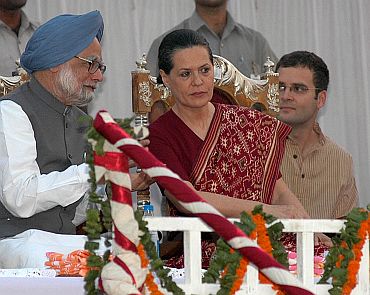
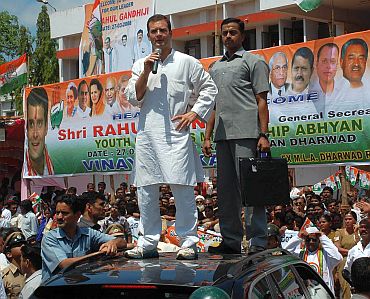
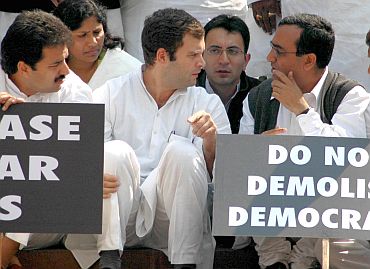
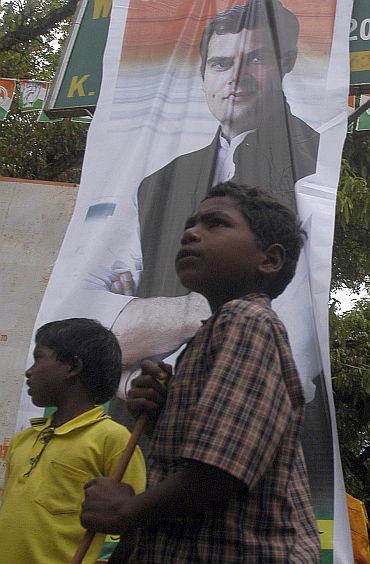
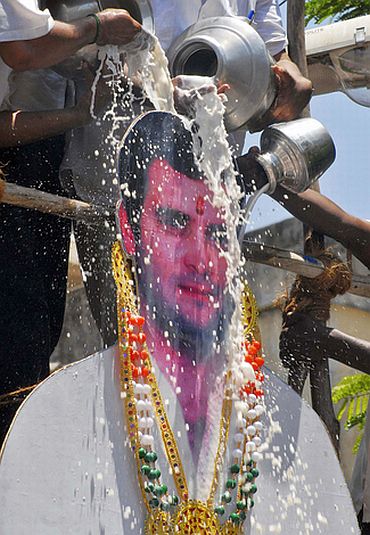
article